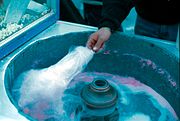
Cotton candy
From Wikipedia, the free encyclopedia
Cotton candy (American English), candy floss (British English), or fairy floss (Australian English) is a form of spun sugar. It was introduced to the world in 1904 by William Morrison and John C. Wharton, at the St. Louis World’s Fair as “Fairy Floss”[1] with great success, selling 68,655 boxes at the then-high 0.25 USD (half the cost of admission to the fair).
Cotton candy is made from sugar and food coloring. Modern cotton candy machines work in very much the same way as older ones. The center part of the machine consists of a small bowl
into which sugar is poured and food coloring added. Heaters near the rim melt the sugar and it is spun out through tiny holes where it solidifies in the air and is caught in a large metal bowl.
The operator of the machine twirls a stick or a cone (or the more experienced ones use their hands) around the rim of the large catching bowl and picks up the candy.
Because cotton candy consists of mostly air portions, servings are large. A typical cotton candy cone will be a bit bigger than an adult’s head. Many people consider eating cotton candy part of the quintessential experience of a visit to a fairground or circus. The most popular color of cotton candy is pink, and it is also popular in other colors like purple, yellow, and blue. Eating cotton candy is often considered only part of its allure, the second part being the act of watching it being produced in a machine. Sweet and sticky, it dissolves quickly in the mouth although it feels like wool to the touch. It does not have much of an aroma although the machine itself has a cooked sugar smell when in operation. Cotton candy is soft and fluffy when dry, but when it comes in contact with moisture, it becomes sticky and damp. Because the sugar is hygroscopic, and has a very large surface area, it will become coarser, harder and generally less “flossy” once exposed to the atmosphere. In humid climates, cotton candy should be eaten within a couple of hours or it will be much less enjoyable.


